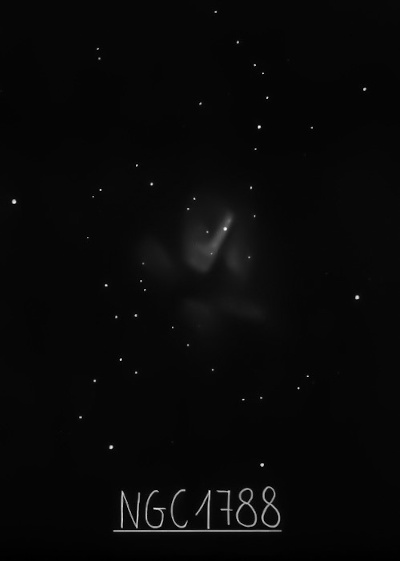
William Herschel discovered NGC 1788 = H V-32 = h347 = Sw. II-30 = Sw. VII-9 on 1 Feb 1786 (sweep 518). His description reads, "cB, vL, milky, diffused and vanishing, very near and sf a bright star, the milkiness diffused and vanishing." On 26 Nov 1786 (sweep 640) he recorded "vL, milky; seems to have some untied stars towards the southern part of it; some other stars are in it, but plainly unconnected. 3 or 4' dia. vF except about the united stars." Joihn Herschel wrote on 11 Feb 1830 (sweep 233), "A *10m with a neb south-following; pos 138 from *; the centre of the neb is like a misty *12 or 13m, or perhaps 2 or 3 st 15m; a small * to the south of neb makes an isosceles triangle. Place that of the *10m." This reflection nebula was observed 21 times at Birr Castle beginning in 1849 (the 1880 publication lists 10 of these).
Lewis Swift found this reflection nebula on 24 Nov 1884 and apparently felt that nebulosity surrounding the 10th mag star on the west side was distinct from Herschel's nebulosity, reporting it as a "nova" in his 2nd discovery list (#30) and his 7th list (#9).
200/250mm - 8" (12/6/80): moderately bright reflection nebula, large, brightest in center, two stars involved, extends to east.
400/500mm - 17.5" (2/9/02): at 144x this is a bright reflection nebula involving two mag 10 and 11.5 stars. The nebulosity is irregularly bright in a 4'x3' region elongated NW-SE and locally very bright in a knot surrounding the mag 11.5 star near the SE end. Enhanced by a Deep Sky filter at low power. The brighter mag 10 star ~2' NW has a faint companion and is also encased in the glow as well as a couple of other fainter stars. A faint extension fans out to the NE from the mag 11 star and some haze is suspected to the south, increasing the size to ~7' and involving a few additional stars. NGC 1788 is located within a bright trapezoid consisting of three mag 8.5-9 stars and a mag 10 star (sides of 9'-13')
17.5" (12/23/89): bright, fairly large, locally very bright surrounding a mag 12 star on the south end. This star appears slightly nonstellar as difficult to separate from bright haze. Extends NW to include a mag 10 star and three other faint stars are involved in the brightest portion. Very faint nebulosity also extends to north and further east.
Notes by Steve Gottlieb